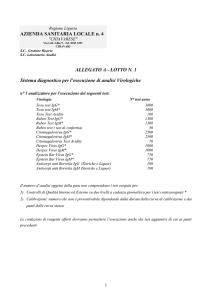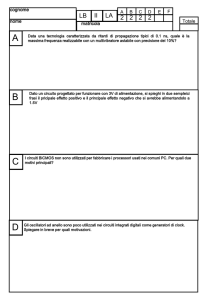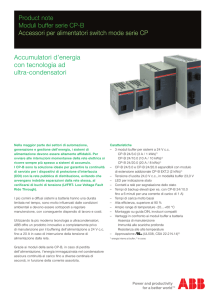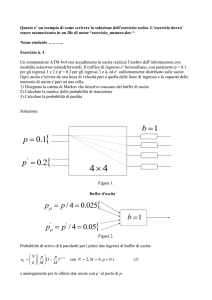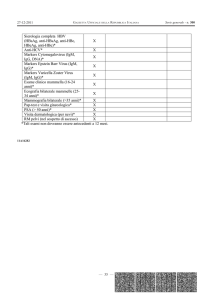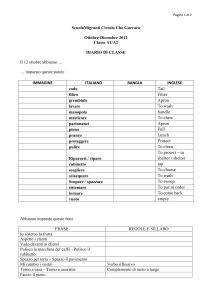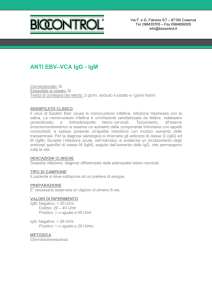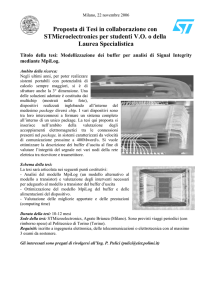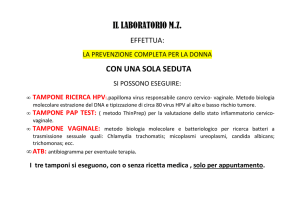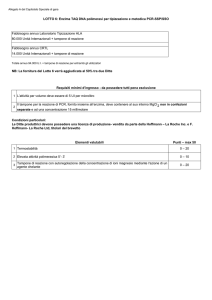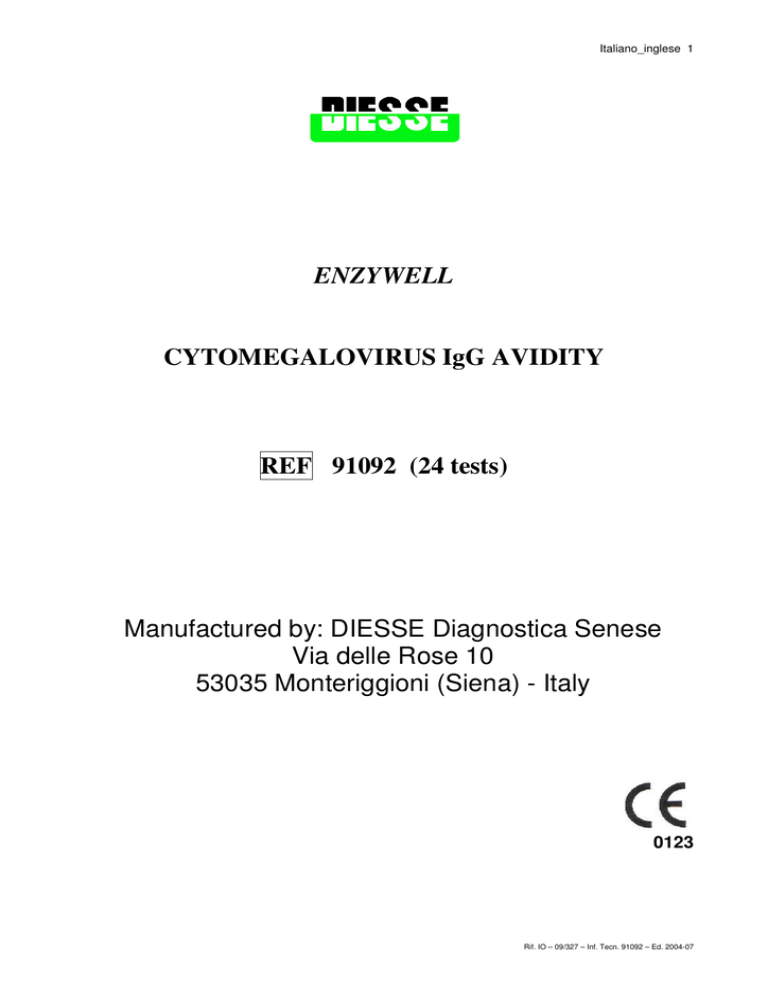
Italiano_inglese 1
ENZYWELL
CYTOMEGALOVIRUS IgG AVIDITY
REF 91092 (24 tests)
Manufactured by: DIESSE Diagnostica Senese
Via delle Rose 10
53035 Monteriggioni (Siena) - Italy
0123
Rif. IO – 09/327 – Inf. Tecn. 91092 – Ed. 2004-07
Italiano_inglese 2
INDICE / INDEX
1.
UTILIZZAZIONE / INTENDED USE / UTILISATION
2.
INTRODUZIONE / SUMMARY AND EXPLANATION OF TEST /INTERET CLINIQUE
3.
PRINCIPIO DEL METODO / PRINCIPLE OF THE TEST / PRINCIPE
4.
COMPOSIZIONE DEL KIT E PREPARAZIONE DEI REAGENTI / KIT CONTENTS AND
REAGENT PREPARATION / CONTENU DU COFFRET ET PREPARATOIN DES REACTIFS
5.
MODALITA’ DI CONSERVAZIONE E STABILITA’ DEI REAGENTI / STORAGE AND
STABILITY OF REAGENTS / MODALITE DE CONSERVATION ET STABILITE DES
REACTIFS
6.
PRECAUZIONI / PRECAUTIONS / PRECAUTIONS D’UTILISATION
7.
TIPO DI CAMPIONE E CONSERVAZIONE / TYPE AND STORAGE OF SAMPLE / TYPE
D’ECHANTLLLON
8.
PROCEDIMENTO / TEST PROCEDURE / MODE OPERATOIRE
9.
SCHEMA DEL SAGGIO / SCHEME OF TEST PROCEDURE / SCHEMA D’ANALYSE
10.
VALIDAZIONE DEL TEST / VALIDATION OF THE TEST / VALIDATION DU TEST
11.
INTERPRETAZIONE DEL TEST / INTERPRETATION OF RESULTS / INTERPRETATION DES
RESULTATS
12.
LIMITAZIONI DELLA PROCEDURA /LIMITATIONS OF THE PROCEDURE / LIMITES DE LA
METHODE
1.13.
SENSIBILITA’ E SPECIFICITA’ DIAGNOSTICA / DIAGNOSTIC SENSITIVITY AND
SPECIFICITY / SENSIBLITE ET SPECIFICITE DIAGNOSTIQUE
13.14.
PRECISIONE / PRECISION
14.15.
GUIDA DEI PROBLEMI DI UTILIZZO / “TROUBLE SHOOTING”
15.16.
BIBLIOGRAFIA / REFERENCES / BIBLIOGRAPHIE
Rif. IO – 09/327 – Inf. Tecn. 91092 – Ed. 2004-07
Italiano_ 3/1414
ISTRUZIONI PER L’USO
ENZYWELL
CYTOMEGALOVIRUS IgG AVIDITY KIT
REF 91092
1.
UTILIZZAZIONE:
METODO IMMUNOENZIMATICO PER LA DETERMINAZIONE DELL’AVIDITA’ DEGLI ANTICORPI
IgG ANTI CYTOMEGALOVIRUS PRESENTI NEL SIERO UMANO
2.
INTRODUZIONE:
Il cytomegalovirus è un herpes virus che si trasmette in stretto contatto interumano.
La maggior parte dei soggetti risulta infettata in modo asintomatico. Il virus, al contrario, è molto pericoloso nei
pazienti immunodepressi nei quali può provocare la morte. Le donne sieronegative che contraggono la malattia durante
la gravidanza la possono trasmettere al feto. Nel 95% dei casi questo avviene senza conseguenze ma nei neonati
sintomatici si può avere ittero, epato-splenomegalia e ritardo psicomotorio. Per questo è molto importante conoscere lo
stato immunitario della paziente ed osservare l'eventuale sieroconversione.
Alcune volte non basta la sola individuazione di anticorpi IgM, poiché la presenza di questi anticorpi può essere dovuta
a persistenza delle IgM o reinfezione asintomatica da cytomegalovirus, senza presentare rischi per il feto.
Per questo risulta utile dosare l'avidità degli anticorpi IgG in quanto è stato dimostrato che questa è bassa nella fase
acuta ed aumenta con il passare del tempo.
Per questo la presenza di anticorpi a bassa avidità è indice di infezione recente o in atto.
L'avidità delle IgG nel siero può essere dosata con questo kit ELISA.
3.
PRINCIPIO DEL METODO:
Il test è basato sul principio ELISA (Enzyme linked Immunosorbent Assay). L'antigene da cytomegalovirus
parzialmente purificato ed inattivato viene legato alla fase solida. Per incubazione con siero umano diluito le
immunoglobuline specifiche si legano all'antigene. Il campione viene deposto in due pozzetti (o in quattro per il test in
duplicato) e lasciato in incubazione. Dopo lavaggio della fase solida, in un pozzetto viene posto il Tampone dissociante
mentre nell'altro soluzione di lavaggio. Il primo tampone provocherà la dissociazione del legame tra antigene ed
anticorpo e questa sarà proporzionale alla avidità degli anticorpi. Dopo lavaggi per eliminare le proteine che non hanno
reagito, si effettua l'incubazione con il coniugato costituito da anticorpi monoclonali anti IgG umane marcati con
l’enzima Perossidasi di rafano.
Si elimina il coniugato che non si è legato e si aggiunge il substrato specifico per l’enzima.
Il colore che si sviluppa è proporzionale alla concentrazione degli anticorpi specifici presenti nel siero in esame rimasti
legati all'antigene legato alla fase solida. Il rapporto tra la densità ottica del pozzetto dove è stato incubato il tampone
dissociante e quella dove è stato incubato il tampone di lavaggio è espresso in percentuale e costituisce la misura
dell'avidità del siero in esame verso l'antigene Cytomegalovirus.
4.
COMPOSIZIONE DEL KIT E PREPARAZIONE DEI REAGENTI
- I reagenti sono sufficienti per 24 determinazioni.
- Portare i reattivi a temperatura ambiente prima dell'uso.
MT PLATE MICROPIASTRA SENSIBILIZZATA CON CYTOMEGALOVIRUS. 3 x 16 pozzetti.
Uso: Aprire l'involucro delle strips dalla parte opposta al codice (C seguito dal numero di lotto) che serve per la sua
identificazione; prendere il supporto ed inserire i pozzetti necessari. Riporre gli altri non utilizzati nella busta di
politene con il gel di silice; fare uscire l'aria e sigillare premendo sulla chiusura.
CONJ CONJUGATE. 1 x 12 mL.
Contenuto: una soluzione di anticorpi monoclonali anti IgG umane marcati con perossidasi in tampone fosfato
contenente fenolo 0,05% e Bronidox 0,02%. Pronto all'uso senza ulteriore diluizione.
CONTROL LOW
CONTROLLO A BASSA AVIDITÀ (2.5 mL)
Rif. IO – 09/327 – Inf. Tecn. 91092 – Ed. 2004-07
Italiano_ 4/1414
Contenuto: Siero umano contenente IgG anti CMV a bassa avidità in tampone fosfato 0.01 mol/L con BSA 1% e sodio
azide 0,09%, liquido , liquido, pronto all'uso senza ulteriore diluizione.
CONTROL HIGH CONTROLLO AD ALTA AVIDITÀ (2,5 mL)
Contenuto: Siero umano contenente IgG anti CMV ad alta avidità in tampone fosfato 0.01 mol/L con BSA 1% e sodio
azide 0,09%, liquido, pronto all'uso senza ulteriore diluizione.
AVIDITY BUF TAMPONE AVIDITY (1 x 10 mL)
Contenuto: Urea in soluzione salina tamponata contenente fenolo (0.05%) e Bronidox (0.02%), pronto all'uso. Se sono
presenti cristalli, discioglierli a 37°C prima dell'uso.
WASH BUF 10x WASH BUFFER 10X. 1 x 100 mL. INTERCAMBIABILE FRA LOTTI
Contenuto: Soluzione salina tamponata (PBS) concentrata 10 volte, contenente Brij 0.5% p/v.
Preparazione: Diluire 1:10 con acqua distillata per ottenere il tampone di lavaggio pronto all'uso. Se sono presenti
cristalli, discioglierli a 37°C prima di diluire.
SAMP DIL 50x
DILUENT 50X. 1 x 4.5 mL. INTERCAMBIABILE FRA LOTTI
Da utilizzare per la diluizione dei campioni.
Contenuto: Soluzione proteica concentrata 50x, contenente BSA 5% p/v e Bronidox 0.02%.
Preparazione: Diluire 1:50 nel tampone di lavaggio per avere il diluente pronto all'uso.
SUBS TMB SUBSTRATE. 12 mL. Pronto all'uso. INTERCAMBIABILE FRA LOTTI
Contenuto: Tetrametilbenzidina ed H2O2 stabilizzati in tampone citrato pH 3,8.
H2SO4 0.3 M STOP SOLUTION. 1 x 16 mL. INTERCAMBIABILE FRA LOTTI
Soluzione di H2SO4 0.3 mol/L pronta all'uso.
PELLICOLA PROTETTIVA (2).
BUSTA DI POLIETILENE (1).
ALTRO MATERIALE RICHIESTO, MA NON FORNITO.
- Incubatore a 37°C
- Lettore di micropiastre (lunghezza d'onda 450 nm o 450/620 nm, con linearità fino ad OD >= 2,000)
- Lavatore di micropiastre (non indispensabile) capace di dispensare volumi nel range 225-375 µl
- Acqua distillata o deionizzata
- Normale vetreria di laboratorio: cilindri, provette, ecc.
- Micropipette e puntali capaci di prelevare accuratamente 10, 100, 1000 µl di soluzione
- Guanti mono-uso
- Contaminuti
- Soluzione al 5% di sodio ipoclorito
- Contenitori per la raccolta di materiali potenzialmente infetti
- Carta assorbente
5.
MODALITA’ DI CONSERVAZIONE E STABILITA’ DEI REAGENTI
I reagenti devono essere conservati a 2/8°C.
La data di scadenza è stampata su ogni componente e sull’etichetta esterna della confezione.
I Reagenti hanno una stabilità limitata dopo apertura e/o preparazione:
REAGENTE
CONDIZIONI
MICROPIASTRA
5 settimane 2/8°C busta di polietilene
SIERI DI CONTROLLO
5 settimane 2/8°C
CONIUGATO
5 settimane 2/8°C
SUBSTRATO
fino alla scadenza a 2/8°C; 1 settimana a 15/30°C; conservare al buio
DILUENTE CAMPIONI
p.uso 2 settimane 2/8°C
WASH BUFFER
p.uso 2 settimane 2/8°C, 5 gg 15/30 °C
AVIDITY BUFFER
fino alla scadenza a 2/8°C.
STOP SOLUTION
fino alla scadenza a 2/8°C
6.
PRECAUZIONI ED AVVERTENZE
SOLO PER USO DIAGNOSTICO IN VITRO
Rif. IO – 09/327 – Inf. Tecn. 91092 – Ed. 2004-07
Italiano_ 5/1414
Questo kit contiene materiali di origine umana che sono stati testati e trovati negativi con test approvati dall’FDA
sia per la ricerca di HbsAg che per quella degli anticorpi anti-HIV-1, anti-HIV-2 ed anti-HCV.. Poiché nessun test
diagnostico può offrire una completa garanzia sull'assenza di agenti infettivi, qualunque materiale di origine
umana deve essere considerato potenzialmente infetto. Tutti i reagenti e i campioni devono essere maneggiati
secondo le norme di sicurezza normalmente adottate in laboratorio.
Avvertenze per la sicurezza personale
1.
2.
3.
4.
5.
6.
Non pipettare con la bocca. Usare guanti monouso e protezione per gli occhi nel maneggiare i campioni e durante
la prova. Lavare accuratamente le mani una volta terminato il test.
I seguenti reagenti contengono concentrazioni basse di sostanze dannose o irritanti:
a) Il tampone di lavaggio contiene detergenti
b) Il coniugato contiene fenolo
c) Il substrato è acido
d) I controlli contengono come conservante sodio azide 0.09% che, con piombo e rame può formare depositi
altamente esplosivi di metallo azidi. Per la sua eliminazione diluire con molta acqua.
Se un reagente viene a contatto con la pelle o con gli occhi, lavare abbondantemente con acqua.
Le apparecchiature non disposable devono essere sterilizzate dopo l'uso, ponendo preferibilmente in autoclave per
1 h a 121°C; i disposables devono essere autoclavati o inceneriti.
L'acido solforico contenuto nello Stop Solution e l'acido cloridrico usato per lavare la vetreria sono corrosivi; tali
sostanze devono essere adoperate con cautela. In caso di contatto con la pelle o gli occhi, lavare abbondantemente
con acqua.
Acidi neutralizzati ed altri rifiuti liquidi devono essere disinfettati aggiungendo sodio ipoclorito in un volume
sufficiente da ottenere una concentrazione finale almeno dell'1%. Un'esposizione al sodio ipoclorito all'1% per 30
minuti dovrebbe essere sufficiente per garantire una disinfezione efficace.
Eventuali versamenti di materiali potenzialmente infetti devono essere rimossi immediatamente con carta
assorbente e la zona inquinata dovrà essere pulito, per esempio con sodio ipoclorito all'1%, prima di proseguire il
lavoro. Se è presente un acido, il sodio ipoclorito non deve essere usato prima che la zona sia stata asciugata. Tutti
i materiali utilizzati per pulire eventuali versamenti accidentali, compresi guanti, devono essere scartati come rifiuti
potenzialmente infetti. Non mettere in autoclave materiali contenenti sodio ipoclorito.
Avvertenze analitiche
1. Prima dell'uso, portare tutti i reagenti ed i campioni a temperatura ambiente (18-30°C). Riporre i reagenti alla
temperatura di conservazione raccomandata immediatamente dopo l'uso. E'importante disporre di una corretta
termostatazione per l'incubazione delle strip. Controllare che il termostato non scenda sotto i 35°C e non
salga oltre i 39°C.
Aprire la busta contenente le strip dopo almeno mezz'ora a temperatura ambiente.
2. Non utilizzare i reagenti dopo la data di scadenza. Evitare l'inquinamento microbico dei reagenti poiché ciò riduce
la validità del prodotto e può dare luogo a risultati errati.
3. Non modificare la Procedura, né sostituire i reagenti con quelli di altri produttori o da altri lotti, a meno che non sia
specificamente riportato che il reagente è intercambiabile fra lotti. Non ridurre i tempi di incubazione
raccomandati.
4. Tutta la vetreria da utilizzare nel test deve essere lavata accuratamente con acido cloridrico 2M e sciacquata con
acqua distillata o deionizzata.
5. Non esporre i reagenti a forte illuminazione né a vapori di ipoclorito durante la conservazione e le fasi di
incubazione.
6. Evitare che i pozzetti si secchino durante il test.
7. Evitare la contaminazione incrociata fra reagenti. E' importante adoperare delle pipette "dedicate" per l'uso.
8. Evitare di toccare il bordo del pozzetto con il coniugato. Non soffiare sulle micropiastre.
9. I dosaggi immunoenzimatici possono talvolta presentare un particolare effetto sul bordo ("edge effect"); si può
minimizzare tale effetto aumentando l'umidità durante le fasi di incubazione. Le piastre devono essere coperte con
i copripiastre ed incubate a 37°C o in bagnomaria usando un sostegno per le piastre, o in incubatore. In
alternativa, le piastre si possono incubare in un analizzatore adatto. Per ulteriori dettagli consultare l'apposito
manuale operativo dello strumento. Non si possono utilizzare incubatori a CO2.
10. Prima di leggere la piastra, assicurarsi che il fondo della piastra sia pulito ed asciutto e che non ci siano bolle d'aria
sulla superficie del liquido.
1.11. Può essere fonte di errori l'uso di campioni fortemente emolizzati, siero non completamente coagulato, o
campioni che presentano inquinamento microbico.
2.12. L’utilizzo del kit su strumenti automatici deve essere validato da parte dell’utilizzatore.
13. Leggere il manuale operativo relativo a qualsiasi strumento utilizzato, ed in particolare con riferimento ai seguenti
punti:
Rif. IO – 09/327 – Inf. Tecn. 91092 – Ed. 2004-07
Italiano_ 6/1414
- installazione e requisiti particolari
- principio operativo, istruzioni, precauzioni, rischi
- specifiche del produttore e performance dello strumento
- manutenzione e assistenza tecnica.
7.
TIPO DI CAMPIONE E CONSERVAZIONE
Il tipo di campione è rappresentato da siero ottenuto per normale venipuntura e maneggiato con appropriati
accorgimenti come richiesto nelle procedure standard di laboratorio. Il siero fresco può essere mantenuto per 4 giorni a
2/8°C per periodi maggiori a –20°C evitare cicli ripetuti di congelamento e scongelamento. I campioni scongelati
devono essere agitati con cura prima del dosaggio. L’inattivazione al calore può fornire risultati erronei. La qualità del
campione può essere seriamente influenzata dalla contaminazione microbica che può portare a risultati erronei.
Campioni fortemente lipemici, itterici o inquinati non dovrebbero essere utilizzati. Se non è possibile il prelievo di un
campione fresco, i campioni dovrebbero essere chiarificati mediante filtrazione (0,45 µm) o centrifugazione (3000 rpm
x 10').
Il test non è applicabile al plasma umano.
8.
-
PROCEDIMENTO
Preparare le strip necessarie
Preparare il tampone di lavaggio diluendo il Wash Buffer 10x (100 ml + 900 ml H2O)
Preparare il diluente dei campioni aggiungendo il DILUENT 50x al tampone di lavaggio (4 ml + 200 ml)
Lasciare un pozzetto vuoto per il bianco. Diluire i campioni 1:301 dispensando 5 µl di siero in 1,5 mL di diluente,
distribuire 100 µl di ciascun campione diluito in almeno due pozzetti, e 100 µl di Controllo Bassa Avidità e 100 µl di
Controllo Alta Avidità in duplicato. Si coprono i pozzetti con la pellicola protettiva e si pone ad incubare per 60' a
37°C. Dopo 4 lavaggi della durata di 30" ciascuno (300 µL), dispensare in un pozzetto sia dei campioni che dei
controlli il Wash Buffer e nell'altro il Tampone Avidity e incubare per 10' a 37°C. Aspirare il tampone ed eseguire 4
lavaggi della durata di 30". Si aggiungono 100 µl di coniugato per ciascun pozzetto e si pone di nuovo ad incubare 45' a
37°C, coprendo i pozzetti con la pellicola protettiva. Si lava di nuovo la piastra per 4 volte come descritto sopra, quindi
si distribuisce il Substrato 100 µl/pozzetto, compreso il bianco. Dopo 15' a temperatura ambiente si blocca la reazione
enzimatica con 100 µl di Stop Solution. Si legge la DO a 450 nm o a 450/620 nm entro 30'.
9.
STEP 1
STEP 2
STEP 3
STEP 4
STEP 5
10.
Schema del protocollo di prova per CYTOMEGALOVIRUS IgG AVIDITY
Mettere 100 µl di siero diluito /controlli in doppio nei pozzetti dello strip.
Incubare 60 min. a 37°C
Lavare 4 volte (300 µL)
Per ciascun campione/controllo distribuire inun pozzetto 100 µl di Wash Buffer e in un
pozzetto 100 µl di Tampone Avidity, incubare 10' a 37°C.
Lavare 4 volte (300 µL)
Mettere 100 µl di coniugato per pozzetto
Incubare 45 min. a 37°C
Lavare 4 volte
Mettere 100 µl di Substrato per pozzetto compreso il bianco
Incubare 15 min. a t.a.
Aggiungere 100 µl di Stop Solution
Leggere l'O.D. a 450 nm entro 30 min.
VALIDAZIONE DEL TEST
Rif. IO – 09/327 – Inf. Tecn. 91092 – Ed. 2004-07
Italiano_ 7/1414
La OD del Bianco deve essere ≤ 0,15.
I controlli alta e bassa avidità nei pozzetti incubati con il Wash Buffer devono riportare un valore di OD > a 0,500.
La percentuale di avidità del controllo bassa avidità deve essere minore del 35% e quello del controllo alta avidità deve
essere maggiore del 50% (calcolata secondo quanto riportato nel paragrafo "Calcolo e Interpretazione del Test").
11.
INTERPRETAZIONE DEL TEST
La percentuale di avidità dei campioni è espressa e calcolata facendo il rapporto tra le densità ottiche trovate nel
pozzetto con Tampone Avidity e quello con Wash Buffer sottratte entrambi del valore del bianco.
D.O. con Tampone Avidity – D.O. bianco
_____________________________
x 100 = % di avidità
D.O. con Wash Buffer – D.O. bianco
Quando questo rapporto è maggiore del 40%, indica la presenza di IgG anti-CMV ad alta avidità, quando è minore del
30% indica la presenza di IgG anti-CMV a bassa avidità. Quando la percentuale è compresa tra 30 e 40% siamo di
fronte a IgG anti-CMV a media avidità (Borderline).
Il calcolo può essere effettuato solo su campioni che hanno una DO del pozzetto lavato con Wash Buffer >= 0.40.
Avvertenza: Per DO <0,40 ripetere il test diluendo il campione 1/101.
12.
LIMITAZIONI DEL METODO
Un risultato di alta avidità (soprattutto in soggetti trapiantati ) non esclude la possibilità che vi sia stata una infezione
recente..
Nel caso di neonati una bassa avidità non è indice di una infezione acuta in atto.
13.
SENSIBILITA’ E SPECIFICITA’ DIAGNOSTICA
In una sperimentazione esterna sono stati testati 100 sieri con due kit del commercio per la determinazione delle IgG e
delle IgM anti Cytomegalovirus. Di tutti i pazienti si conosceva il quadro clinico .
La % di avidità calcolata è stata correlata con lo stadio dell’infezione.
Dei 100 campioni analizzati 14 appartenevano a soggetti con infezione acuta, 15 appartenevano a pazienti provenienti
da reparti di trapiantati (7 con infezione acuta) , il resto apparteneva a pazienti con infezioni pregresse .
La % di avidità nei 14 pazienti con infezione acuta variava da un minimo di 6 ad un massimo di 35-40 (infezioni
primarie avanzate) ,nelle infezioni pregresse l’avidità variava da un minimo di 50 ad un massimo di 100 (superiore o
uguale a 70 nel 61% dei casi) . I soggetti trapiantati mostravano alti valori di avidità ; il risultato era falsato dalla
somministrazione di gamma globuline che in questi pazienti viene comunemente effettuata.
14
PRECISIONE
Tab.1 Precisione nella prova (n=6)
Campione
Bassa Avidità
Alta Avidità
% media avidità
28
92
D.S.
2
3
CV%
6
3
Tab.2 Precisione tra prove e tra lotti
Campione
% media avidità
S1
72
S2
31
S3
8
D.S.
1
1
2
CV%
15
2
28
15.
GUIDA DEI PROBLEMI DI UTILIZZO
PROBLEMA
Seduta invalida (tutti negativi)
POSSIBLI FONTI DI ERRORE
Uno o più reagenti non sono stati
aggiunti oppure sono stati aggiunti
in ordine errato
Piastra non reattiva
AZIONI DA INTRAPRENDERE
Controllare nuovamente la procedura.
Controllare se qualche reagente non è stato
aggiunto.
Ripetere il test.
Controllare il codice sulla busta della piastra
(vedi informazioni tecniche punto 4 per il
Rif. IO – 09/327 – Inf. Tecn. 91092 – Ed. 2004-07
Italiano_ 8/1414
Seduta invalida (tutti positivi)
Inquinamento del substrato
Lavaggio inadeguato
Scarsa precisione
Aspirazione inadeguata dei pozzetti
codice corretto).
Controllare la presenza di umidità nella
piastra inutilizzata. (Il gel di silice deve
essere giallo pallido) Ripetere il test.
Prelevare una nuova aliquota del substrato.
Assicurarsi del buon funzionamento del
lavatore
Assicurarsi del buon funzionamento del
lavatore
Errore del pipettamento
Aggiunta dei reagenti troppo lenta
Insufficiente sviluppo di colore
Controllare il funzionamento della pipetta
Evitare l’essiccamento della piastra dopo il
lavaggio. Aggiungere i reattivi
immediatamente.
Presenza di bolle d’aria
Evitare la formazione di bolle d’aria durante
il pipettamento
Percorso ottico non limpido
Controllare la fonte luminosa per la presenza
di sporco. Pulire il fondo della piastra con
fazzoletto di carta.
Tempo o temperatura di incubazione Verificare il monitoraggio della temperatura
non corretto
ed il tempo di incubazione
Seguire attentamente le istruzioni per l’uso.
Substrato aggiunto in volume
Controllare il funzionamento della pipetta.
inadeguato
17.
BIBLIOGRAFIA / REFERENCES
1. L. Grangeot-Keros, M.J. Mayaux, P. Lebon et al. Value of CMV IgG avidity index for the diagnosis of primary
CMV infection in pregnant women. J. Inf. Dis. 175: 944 (1997).
2. N.K. Blackburn, T.G. Besselaar et al. Differentiation of primary cytomegalovirus infection from reactivation using
the urea denaturation test for measuring antibody avidity. J. Med. Virol. 33: 6 (1991).
3. G.B. Wisdom. Enzyme-immunoassay. Clin. Chem. 22: 1243 (1976).
0123
DIESSE Diagnostica Senese
Via delle Rose 10
53035 Monteriggioni (Siena) Italy.
Tel. 0577-587111
Rif. IO – 09/327 – Inf. Tecn. 91092 – Ed. 2004-07
English_ 9/1414
INSTRUCTIONS FOR USE
ENZYWELL
CYTOMEGALOVIRUS IgG AVIDITY KIT
REF 91092
1.
INTENDED USE:
IMMUNOENZYMATIC METHOD FOR THE DETERMINATION OF THE
ANTIBODIES TO CYTOMEGALOVIRUS IN HUMAN SERUM
AVIDITY OF IgG-CLASS
2.
SUMMARY AND EXPLANATION OF THE TEST:
Cytomegalovirus is a herpes virus transmitted by close human contact. No symptoms of infection are apparent in the
majority of cases. However, the virus is very dangerous and may be fatal in immunodepressed patients. Serum-negative
female patients who become infected during pregnancy may transmit the disease to the fetus. In 95% of cases this
occurs without symptoms, but some neonates may present jaundice, hepato-splenomegaly and retarded psycho-motorial
development. For this reason it is of great importance to determine the immunitary state of the patient and check for
serum conversion.
Sometimes it is not sufficient to test for IgM antibodies, as the presence of this class may be due to the persistence of
IgM or asymptomatic reinfection by Cytomegalovirus, without risk for the fetus.
For this reason it is useful to assay the avidity of the IgG antibodies, in as far as it has been demonstrated that avidity is
low in the acute phase of infection and increases over a period of time. The presence of low avidity antibodies is
therefore an indication of a recent or current infection. The avidity of IgG antibodies in the serum can be assayed with
this ELISA kit.
3.
PRINCIPLE OF THE TEST:
The test is based on the ELISA technique (Enzyme linked Immunosorbent Assay) (1-3).
The partially purified and inactivated Cytomegalovirus antigen is bound to the solid phase. The specific
immunoglobulins are bound to the antigen through incubation with dilute human serum. The sample is placed in two
wells (or in four wells if the test is performed in duplicate) and left to incubate.
After washing of the solid phase, the Avidity Buffer is placed in one well and the rinsing buffer in the other. The
avidity buffer will cause dissociation of the antigen/antibody bond, proportional to the avidity of the antibodies. After
washings to eliminate the proteins that have not reacted, incubation is performed with the conjugate composed of antihuman IgG monoclonal antibodies labelled with horse-radish peroxidase.
The unbound conjugate is eliminated and the peroxidase substrate specific for the enzyme is added.
The colour which develops is proportional to the concentration of specific antibodies present in the serum sample still
bound to the antigen on the solid phase. The ratio between the OD of the well containing the Avidity buffer and that
containing the Wash Buffer is expressed as a percentage and gives the degree of avidity of the serum sample for the
Cytomegalovirus antigen.
4.
KIT CONTENTS AND REAGENT PREPARATION:
Reagents are sufficient for 48 determinations.
1.- Bring reagents to room temperature before use.
MT PLATE MICROPLATE COATED WITH CYTOMEGALOVIRUS. 3x16 wells.
Use: open the package at the opposite end from the code (C, followed by the lot number) which is useful for
identification purposes, remove the support and wells to be used from the foil package, and place the unused wells in
the polythene bag with the silica gel, expel the air and seal by pressing the closure.
CONJ CONJUGATE. 1x12 mL.
Contents: anti-human IgG monoclonal antibodies labelled with Peroxidase, in phosphate buffer solution. Ready for use
without further dilution.
CONTROL HIGH
HIGH AVIDITY CONTROL (2.5 mL)
Rif. IO – 09/327 – Inf. Tecn. 91092 – Ed. 2004-07
English_ 10/1414
Contents: Human serum containing low avidity IgG anti-CMV in Phosphate buffer 0.01 mol/L with BSA 1% and
sodium azide 0.09%, liquid, ready for use without further dilution.
CONTROL LOW
LOW AVIDITY (2.5 mL) CONTROL (2.5 mL)
Contents: Human serum containing high avidity IgG anti-CMV in Phosphate buffer 0.01 mol/L with BSA 1% and
sodium azide 0.09%, liquid, ready for use without further dilution.
AVIDITY BUF AVIDITY BUFFER (1 x 10 mL)
Contents: Urea in buffered saline solution containing phenol (0.05%) and Bronidox (0.02%), ready for use. If crystals
are present, they should be dissolved at 37°C before use.
WASH BUF 10x WASH BUFFER 10X. 1 x 100 mL. INTERCHANGEABLE BETWEEN LOTS
Contents: Phosphate buffered saline, concentrated 10 times; contains Brij 0.5% w/v.
Preparation: dilute 1:10 with distilled water in order to obtain the washing buffer ready for use. If crystals are present,
they should be dissolved at 37°C before dilution.
DILUENT 50X. 1 x 4.5 mL. For dilution of serum samples. INTERCHANGEABLE
SAMP DIL
50x
BETWEEN LOTS
Contents: Proteic solution conc. 50 times, containing BSA 5% w/v and bronidox 0.02%.
Preparation: Dilute 1:50 in the washing buffer to obtain the diluent ready for use.
SUBS TMB SUBSTRATE. 12 mL. Ready for use. INTERCHANGEABLE BETWEEN LOTS
Contents: Tetramethylbenzidine and hydrogen peroxide stabilised in citrate buffer, pH 3.8.
H2SO4 0.3 M STOP SOLUTION. 1x16 mL. INTERCHANGEABLE BETWEEN LOTS
H2SO4 0.3 mol/L, in solution ready for use.
ADHESIVE FILMS (2).
POLYTHENE BAG (1).
MATERIALS REQUIRED BUT NOT PROVIDED.
- Microplate reader, wavelength 450 nm or 450/620 nm, with OD linearity up to 2,000 (at least).
- Microplate washer (preferable) able to dispense volumes in the range 225-375 µL
- Distilled or deionized water
- Normal laboratory glassware: cylinders, test-tubes etc.
- Micropipettes for the accurate collection of 10, 100, 1000 µl solution
- Disposable gloves
- Timer
- Sodium Hypochlorite solution (5%)
- Containers for collection of potentially infectious materials
- Absorbent tissue.
5.
STORAGE AND STABILITY OF REAGENTS
Reagents must be stored at 2/8°C.
The expiry date is printed on each component and on the box label.
Reagents have a limited stability after opening and/or preparation
REAGENT
CONDITIONS
Microplate
5 weeks at 2/8°C, polythene bag
Control sera
5 weeks at 2/8°C
Conjugate
5 weeks at 2/8°C
Substrate
up to the expiry date at 2/8°C, 1 week at 15-30°C; store in the dark
Sample Diluent
ready for use, 2 weeks at 2/8°C
Wash Buffer
2 weeks at 2/8°C, 5 days at 15/30°C.
Avidity Buffer
up to the expiry date at 2/8°C
Stop Solution
up to the expiry date at 2/8°C
6.
PRECAUTIONS
FOR IN VITRO DIAGNOSTIC USE ONLY.
Rif. IO – 09/327 – Inf. Tecn. 91092 – Ed. 2004-07
English_ 11/1414
This kit contains materials of human origin which have been tested and gave a negative response by FDA-approved
methods for the presence of HbsAg and for anti-HIV-1, anti-HIV-2 and anti-HCV antibodies. As no diagnostic test
can offer a complete guarantee regarding the absence of infective agents, all material of human origin must be
handled as potentially infectious. All precautions normally adopted in laboratory practice should be followed when
handling material of human origin.
Health and Safety Information
1. Do not pipette by mouth. Wear disposable gloves and eye protection while handling specimens and performing the
assay. Wash hands thoroughly when finished.
2. The following reagents contain low concentrations of harmful or irritant substances:
a) The Wash Buffer contains detergents
b) The conjugate contains phenol
c) The substrate is acid
d) Calibrators contain Sodium Azide 0.09% as preservative which may react with copper and lead in plumbing
to form potentially explosive metal azides. On disposal, flush with large volumes of water to prevent azide
buildup.
If any of the reagents come into contact with the skin or eyes, wash the area extensively with water.
3. Non-disposable apparatus should be sterilized after use. The preferred method is to autoclave for 1 h at 121°C;
disposables should be autoclaved or incinerated.
4. Sulphuric acid required for the Stop Soution and hydrochloric acid used for washing glassware are corrosive and
should be handled with appropriate care. If they come into contact with the skin or eyes, wash thoroughly with
water.
5. Neutralized acids and other liquid waste should be decontaminated by adding a sufficient volume of sodium
hypochlorite to obtain a final concentration of at least 1.0%. A 30 minute exposure to 1% sodium hypochlorite
may be necessary to ensure effective decontamination.
6. Spillage of potentially infectious materials should be removed immediately with adsorbent paper tissue and the
contaminated area swabbed with, for example, 1.0% sodium hypochlorite before work is continued. Sodium
hypochlorite should not be used on acid-containing spills unless the spill area is first wiped dry. Materials used to
clean spills, including gloves, should be disposed of as potentially biohazardous waste. Do not autoclave materials
containing sodium hypochlorite.
Analytical precautions
1. Allow all reagents and samples to come to room temperature (18-30°C) before use. Immediately after use return
reagents to the recommended storage temperature. It is important to work at the correct temperature. Check
that the thermostat does not go below 35°C or over 39°C. Open the envelope containing the strips after at least
½ hr at room temperature.
2. Do not use the reagents beyond the stated expiry date. Microbiological contamination of reagents must be avoided
as this may reduce the life of the product and cause erroneous results.
3. Do not modify the Test Procedure or substitute reagents from other manufacturers or other lots unless the reagent
is stipulated as interchangeable. Do not reduce any of the recommended incubation times.
4. Any glassware to be used with the reagents sbould be thoroughly washed with 2M hydrochloric acid and then
rinsed with distilled water or high quality deionized water.
5. Do not expose reagents to strong light or hypochlorite fumes during storage or during incubation steps.
6. Do not allow wells to become dry during the assay procedure.
7. Care must be taken not to cross-contaminate reagents. It is important that pipettes are dedicated for excusive use
with the various reagents.
8. Care should be taken to avoid touching or splashing the rim of the well with conjugate. Do not "blow-out" from
microplates.
9. Enzyme immunoassays can occasionally exhibit an "edge effect" which must be minimized by increasing the
humidity during incubation steps. Plates must be covered with their covers and incubated at 37°C either in a water
bath with a rack or float to support the plates if necessary, or in an incubator. Alternatively, plates can be incubated
in an approved analyzer. See the appropriate operating manual for further details. CO2 incubators must not be used.
10. Ensure that the bottom of the plate is clean and dry, and that no bubbles are present on the surface of the liquid
before reading the plate.
11. Use of highly hemolyzed samples, incompletely clotted sera, or samples with microbial contamination may give
rise to erroneous results.
16.12. The use of the kit with automated instruments must be validated by the user.
17.13. For each instrument used, read the manufacturer's instructions manual carefully to obtain additional information
on the following points:
- installation and particular requisites
- operating principles, instructions, precautions and risks
Rif. IO – 09/327 – Inf. Tecn. 91092 – Ed. 2004-07
English_ 12/1414
-
- manufacturer's specifications and instrument performance
servicing and maintenance.
7.
TYPE AND STORAGE OF SAMPLE
The sample is composed of serum collected in the normal manner from the vein and handled with all precautions
dictated by good laboratory practice. The fresh serum may be stored for 4 days at 2/8°C, or frozen for longer periods at
–20°C; avoid repeated freezing/thawing cycles.. Defrosted samples must be carefully shaken before performing the
test. Heat inactivation can lead to erroneous results. The quality of the sample can be seriously affected by microbial
contamination which leads to erroneous results.
Strongly lipemic, icteric or contaminated samples should be avoided. If a new sample cannot be obtained, such samples
should be clarified by filtration (0.45 µm) or centrifugation (3000 rpm x 10').
The test cannot be performed on human plasma.
8.
2.3.4.-
TEST PROCEDURE:
Prepare the required number of strips.
Prepare the washing buffer by diluting the Wash Buffer 10x (100 mL + 900 mL H2O).
Prepare the diluent for samples by adding Diluent 50x to the washing buffer (add 4 mL to 200 mL).
Leave a well empty for the test blank. Dilute samples 1:301 distributing 5 µl of serum into 1.5 mL of diluent. Dispense
100 µL of each diluted sample in at least two wells, and 100 µl of High Avidity Control and 100 µl of Low Avidity
Control in duplicate. Wells are covered with protective film and incubated for 60 minutes at 37°C. After washing four
times for 30 seconds (300 µL), dispense Wash Buffer in one well of the serum samples and of the controls and Avidity
Buffer in the other, and incubate for 10' at 37°C. Aspirate the buffer and perform 4 washings for 30 seconds each. Add
100 µl of conjugate to each well and incubate again for 45 minutes at 37°C, covering the wells with the protective film.
The plate is washed again 4 times, as described above. Finally, the substrate is distributed, 100 µl/well., including the
blank. After 15 minutes at room temperature the enzymatic reaction is stopped with 100 µl of Stop Solution.
The adsorbance (O.D.) is read at 450 nm or at 450/620 nm within 30 min.
9.
STEP 1
STEP 2
STEP 3
STEP 4
STEP 5
TEST PROCEDURE FOR CYTOMEGALOVIRUS IgG AVIDITY KIT
Place 100 µl of diluted sample /controls in duplicate in the wells of the strips.
Incubate for 60 min. at 37°C
Wash 4 times (30 seconds each, 300 µL)
For each sample/control , place 100 µl of Wash Buffer in one well and 100 µl of
Avidity buffer in the other; incubate for 10' at 37°C
Wash four times (30 seconds each, 300 µL)
Add 100 µl of conjugate to each well
Incubate for 45 min. at 37°C
Wash 4 times
Add 100 µl of Substrate to each well including the blank
Incubate for 15 min. at R.T.
Add 100 µl of Stop Solution
Read absorbance at 450 nm within 30 min
10.
QUALITY CONTROL VALUES
The OD of the Blank must be ≤ 0.15.
The high and low avidity controls in the wells incubated with the Wash Buffer must give an OD value > 0.500. The
percentage of avidity of the low control must be less than 35%, and the high avidity control must be higher than 50%
compared to that found with the Wash Buffer. (Calculation performed as reported in the following paragraph).
Rif. IO – 09/327 – Inf. Tecn. 91092 – Ed. 2004-07
English_ 13/1414
11.
INTERPRETATION OF THE RESULTS
The percentage of avidity of the samples is expressed and calculated using the ratio between the OD found in the wells
containing Avidity buffer and those with Wash Buffer., subtracting the value of the blank.
O.D. with Avidity Buffer – O.D. blank
_____________________________
x 100 = % of avidity
O.D. with Wash Buffer – O.D. blank
A ratio over 40% indicates the presence of high avidity IgG antibodies; when it is lower than 30%, this indicates the
presence of low avidity IgG. If the percentage is between 30 and 40%, there is a medium degree of avidity (borderline).
The calculation can only be performed on samples with give an OD >= 0.40 in the well washed with Wash Buffer.
Warning: In the case of O.D. <0.40, repeat the test diluting the sample 1/101.
12. LIMITATIONS OF THE TEST
A finding of high avidity (especially in transplanted subjects) does not exclude the possibility of a recent infection.
In the case of newborn babies, low avidity is not a sign of an acute infection in progress.
13. DIAGNOSTIC SENSITIVITY AND SPECIFICITY
In an external evaluation, 100 serum samples were tested with two commercial kits for the determination of anti-CMV
IgG and IgM. The clinical picture of all patients was known.
The % avidity calculated was correlated with the stage of infection. Of the 100 samples tested, 14 were from patients
with an acute infection, 15 from patients who had undergone transplant (7 of which with an acute infection), the rest
came from patients with a prior infection.
The percentage of avidity in the 14 patients with acute infections varied from a minimum of 6 to a maximum, of 35-40
(advanced primary infections); in the cases of previous infections the avidity varied from a minimum of 50 to a
maximum of 100 (>= 70 in 61% of cases). The transplanted patients showed high avidity levels; the result was
falsified by the administration of gammaglobulins, which is often given in these patients).
14. PRECISION
Table 1 Precision “in run” (n=6)
Sample
Low avidity
High avidity
average % avidity
28
92
S.D.
2
3
CV%
6
3
Table 2 Precision “between runs”
Sample
average % avidity
S1
72
S2
31
S3
8
S.D.
1
1
2
CV%
15
2
28
15.
TROUBLE SHOOTING GUIDE
PROBLEM
Invalid run (all negative)
POSSIBLE SOURCE
One or more reagents not added or
added in wrong sequence
Unreactive plate
Invalid run (all positive)
Contamination of substrate
Inadequate washing
TEST OR ACTION
Recheck procedure
Check for unused solutions. Repeat test.
Check the code on the package containing
the plate (see package insert point 4 for
correct code).
Check for moisture in unused plate. (Silica
gel dessiccant must be pale yellow ).Repeat
test
Take new aliquot of substrate.
Ensure that wash apparatus works well
Rif. IO – 09/327 – Inf. Tecn. 91092 – Ed. 2004-07
English_ 14/1414
Poor precision
Incomplete washing of wells
Inadequate aspiration of wells
Pipetting error
Reagent addition too slow
Presence of bubbles
Optical pathway not clean
Inadequate Color development
Incorrect incubation times or
temperature
Inadequate volume of substrate
added to the plate
16.
Ensure that wash apparatus works well
Ensure that wash apparatus works well
Check pipette function
Avoid drying of the plate after washing step.
Add reagents immediately
Avoid air bubbles during pipetting.
Check instrument light source and detector
for dirt. Wipe bottom of plate with soft
tissue.
Check for temperature control and time
monitoring
Adhere to recommended instruction for use.
Check pipette function.
REFERENCES
L. Grangeot-Keros, M.J. Mayaux, P. Lebon et al. Value of CMV IgG avidity index for the diagnosis of
primary CMV infection in pregnant women. J. Inf. Dis. 175: 944 (1997).
2. N.K. Blackburn, T.G. Besselaar et al. Differentiation of primary cytomegalovirus infection from reactivation
using the urea denaturation test for measuring antibody avidity. J. Med. Virol. 33: 6 (1991).
3. G.B. Wisdom. Enzyme-immunoassay. Clin. Chem. 22: 1243 (1976).
1.
0123
DIESSE Diagnostica Senese
Via delle Rose 10
53035 Monteriggioni (Siena) Italy.
Rif. IO – 09/327 – Inf. Tecn. 91092 – Ed. 2004-07

